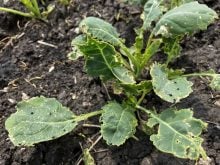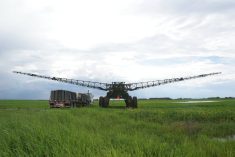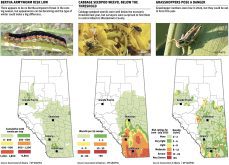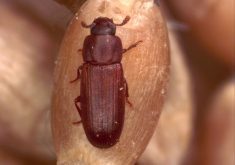Increased moisture to blame | Cabbage seed pod weevil in canola is also expected to cause major problems this year
Wheat growers in eastern Saskatchewan will likely face significant wheat midge infestation this year, according to the provincial forecast.
Surveys done last fall found that the regions of greatest risk will be the black and dark brown soil zones in east-central and southeastern areas. Wheat midge is commonly a problem in these regions but is expected to be found in significant numbers this year.
The soil sampling, which looked for viable midge larvae and cocoons, also found increased populations in the brown soil zone of south-central and southwestern Saskatchewan, where the pest typically isn’t as big a problem. There is also a pocket around Prince Albert.
Read Also

Farming Smarter receives financial boost from Alberta government for potato research
Farming Smarter near Lethbridge got a boost to its research equipment, thanks to the Alberta government’s increase in funding for research associations.
Scott Hartley, the provincial insect specialist, said the increased moisture in those areas is likely the reason.
“If you look at previous maps, it will go southeast to northwest following along the dark brown and black soil zones,” he said.
“Because moisture favours (midge), the good moisture in the southwest is something that’s brought it up higher than most years.”
Moisture conditions are usually better in eastern Saskatchewan, and that’s where midge is a perennial problem.
This year, the size of the affected area is expected to be bigger than last year, Hartley said.
However, he said the forecast map is based on cocoons.
“We know that population is there, but will it materialize will depend on conditions,” he said.
The forecast was based on 420 soil samples collected last fall.
Most of the province is expected to see midge in numbers less than 600 per sq. metre, but the regions expecting large numbers are looking at more than 1,800 per sq. metre.
Hartley said producers who grow wheat in areas where 1,200 midge or more are forecast should budget for the cost of insecticide application. It might not be required, but it’s better to budget for it than be caught off guard, he said.
Also, significant damage and yield loss can still occur at lower numbers of midge.
Hartley said weather conditions will be a factor in midge emergence and the ability to spray.
“If you don’t get 20 millimetres of precipitation by the end of May, it’ll delay (midge emergence) and then sometimes your crop staging isn’t going to fit in with when the midge is a problem,” he said.
“You might not have the populations there, just depending on when spring precipitation was. It needs that in order to go into a pupal stage and then emerge.”
Farmers concerned about midge could consider growing a different crop or seeding a midge-tolerant variety.
Midge typically become a problem in late June and early July.
Hartley said farmers should also be watching for cabbage seed pod weevil in canola this year. It has been steadily moving eastward through southern Saskatchewan for the last 14 years but is now north of the South Saskatchewan River and heading into more traditional canola-growing country.
The pest will likely expand more rapidly once it reaches more canola fields.
“Where we think it’s going to end up doing really well is southern Manitoba,” Hartley said.
He also said grasshopper numbers look low, but there will be some problem areas.
“If we keep getting 20 mm of rain every couple of days, that’s not going to help them but will help the midge,” he said.


















